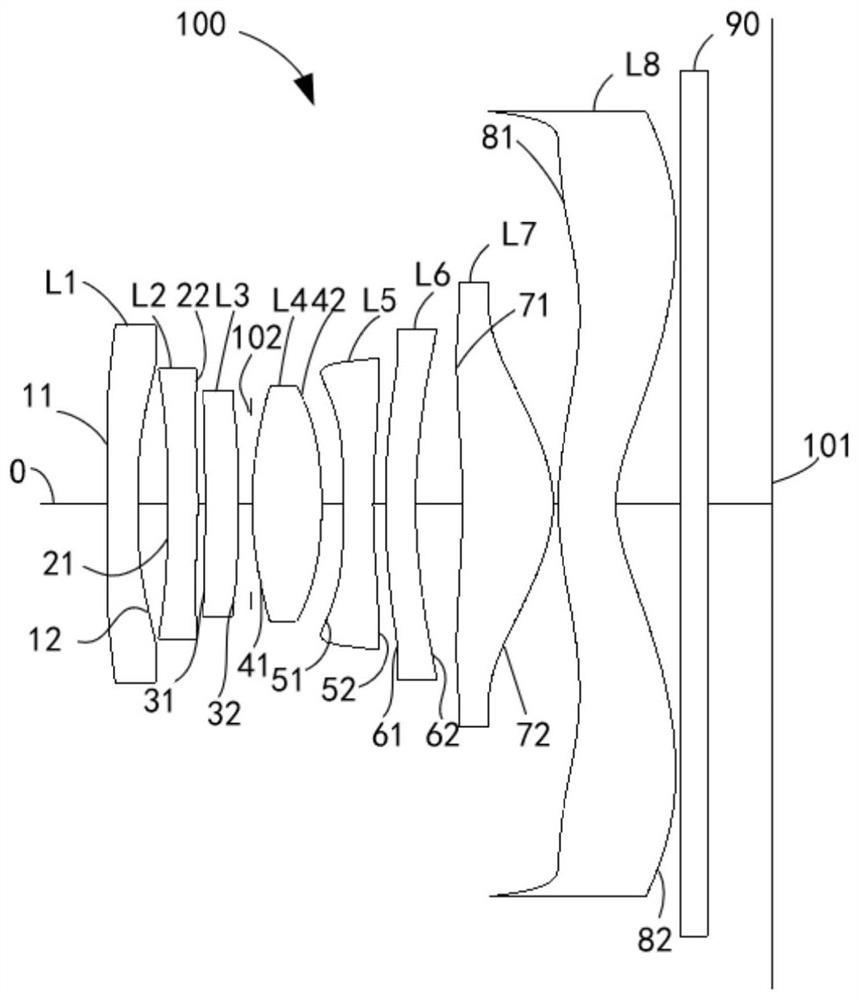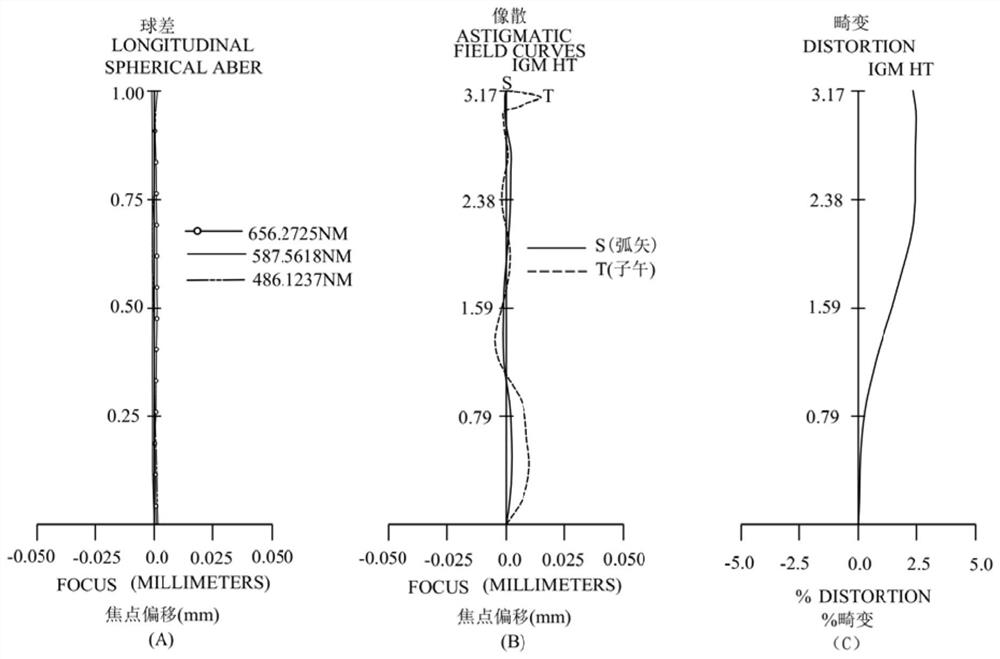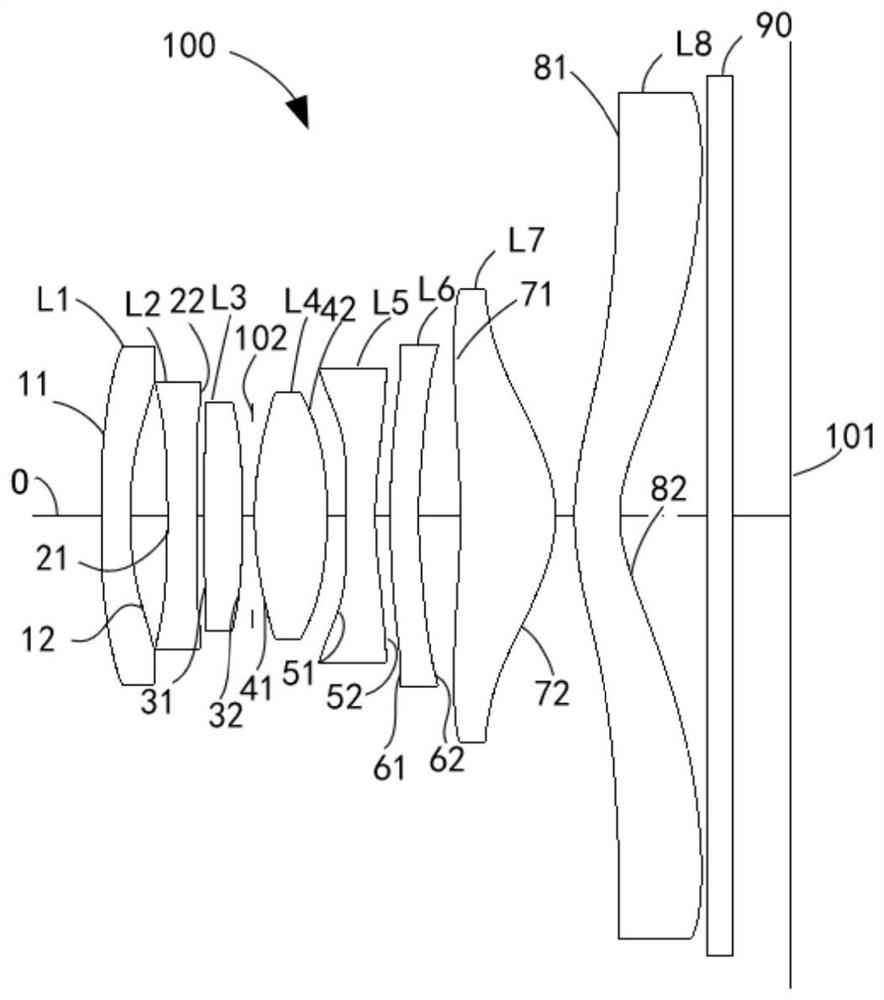Optical lens, camera module and electronic equipment
An optical lens and camera module technology, applied in the field of optical imaging, can solve the problems of increased processing and molding difficulty, and achieve the effect of improving the capture ability and meeting the needs of high image quality design.
- Summary
- Abstract
- Description
- Claims
- Application Information
AI Technical Summary
Problems solved by technology
Method used
Image
Examples
no. 1 example
[0096] The structural diagram of the optical lens 100 disclosed in the first embodiment of the present application is as follows figure 1 As shown, the optical lens 100 includes a first lens L1, a second lens L2, a third lens L3, a diaphragm 102, a fourth lens L4, a fifth lens L5, a first lens L1, and a second lens L1 arranged in sequence from the object side to the image side along the optical axis O. Six lenses L6, seventh lens L7, eighth lens L8 and infrared filter 90.
[0097] Among them, the refractive power distribution of the above-mentioned eight-piece lens is shown in Table 1 below:
[0098] Table 1
[0099] Lens code L1 L2 L3 L4 L5 L6 L7 L8 Inflection force distribution burden just burden just burden burden just burden
[0100] Further, both the first object side 11 and the first image side 12 are concave at the near optical axis, the second object side 21 is concave at the near optical axis, and the second image side 22 i...
no. 2 example
[0116] Please refer to image 3 , image 3 It is a schematic structural diagram of the optical lens 100 according to the second embodiment of the present application. The optical lens 100 includes a first lens L1, a second lens L2, a third lens L3, a diaphragm 102, a fourth lens L4, a fifth lens L5, and a sixth lens L6 arranged in sequence from the object side to the image side along the optical axis O , the seventh lens L7, the eighth lens L8 and the infrared filter 90.
[0117] Among them, the refractive power distribution of the above-mentioned eight-piece lens is shown in Table 4 below:
[0118] Table 4
[0119] Lens code L1 L2 L3 L4 L5 L6 L7 L8 Inflection force distribution burden burden just just burden burden just burden
[0120] Further, the first object side 11 and the first image side 12 are respectively convex and concave at the near optical axis, the second object side 21 is concave at the near optical axis, and the se...
no. 3 example
[0134] Please refer to Figure 5 , Figure 5 A schematic structural diagram of the optical lens 100 according to the third embodiment of the present application is shown. The optical lens 100 includes a first lens L1, a second lens L2, a third lens L3, a diaphragm 102, a fourth lens L4, a fifth lens L5, and a sixth lens L6 arranged in sequence from the object side to the image side along the optical axis O , the seventh lens L7, the eighth lens L8 and the infrared filter 90.
[0135] Among them, the refractive power distribution of the above-mentioned eight-piece lens is shown in Table 7 below:
[0136] Table 7
[0137] Lens code L1 L2 L3 L4 L5 L6 L7 L8 Inflection force distribution burden burden just just burden just just burden
[0138] Further, both the first object side 11 and the first image side 12 are concave at the near optical axis, the second object side 21 is concave at the near optical axis, and the second image side 2...
PUM
 Login to View More
Login to View More Abstract
Description
Claims
Application Information
 Login to View More
Login to View More - R&D
- Intellectual Property
- Life Sciences
- Materials
- Tech Scout
- Unparalleled Data Quality
- Higher Quality Content
- 60% Fewer Hallucinations
Browse by: Latest US Patents, China's latest patents, Technical Efficacy Thesaurus, Application Domain, Technology Topic, Popular Technical Reports.
© 2025 PatSnap. All rights reserved.Legal|Privacy policy|Modern Slavery Act Transparency Statement|Sitemap|About US| Contact US: help@patsnap.com



